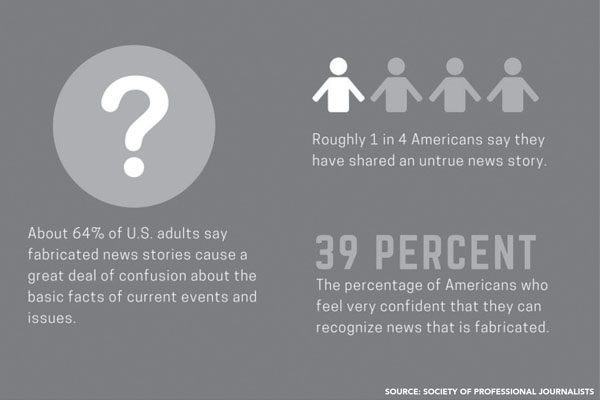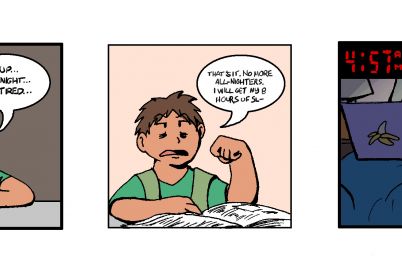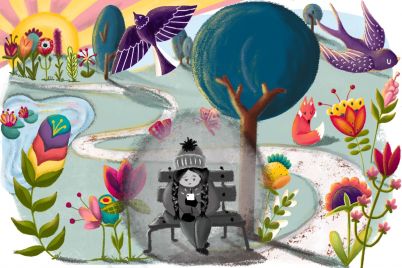
Information courtesy of the Society of Professional Journalists
By Rachel Duckett
Contributor
Some Americans may read, or watch the news daily, while some of us almost never watch the news. Most of us fall somewhere in between, reading headlines on our phones as we walk from class to class, occasionally watching the news when it’s on.
Whether you intake a lot of news, or barely any, you’ve probably heard the term “fake news” thrown around in the past few years.
“Fake news has typically been studied along four lines: characterization, creation, circulation, and countering. How to characterize fake news has been a major concern in the research literature, as the definition of the term is disputed,” said Bente Kalsnes of Oslo Metropolitan University in an article.
I’ve observed fake news in three forms: clickbait, or tabloid articles that are designed to maximize tabloid sales, or online ad revenue by grabbing your attention with outlandish headlines, completely false information being spread by unreliable sources, and most commonly, twisted, incomplete or sensationalized truth that is spread around to fit a certain bias or narrative.
In an article published through Harvard’s Nieman Journalism Lab, Julian Matthews, research officer at the Cognitive Neurology Lab of Monash University, said, “Fake news often relies on misattribution—instances in which we can retrieve things from memory but can’t remember their source. Misattribution is one of the reasons advertising is so effective. We see a product and feel a pleasant sense of familiarity because we’ve encountered it before, but fail to remember that the source of the memory was an ad.”
While fake news as a buzzword is fairly new, misinformation has existed as long as humans have been able to communicate with one another.
In the 1890s, there was a “circulation battle” in New York, led by William Randolph Hearst of the New York Journal and Joseph Pulitzer of the New York World. Basically, these two publications did all they could to outsell the other, relying mostly on sensationalist headlines and drawings.
During this time, Cuba was seeking independence from Spain. As a country that had fought for its own independence before, many Americans expressed sympathy towards Cuba and its revolution. Pulitzer and Hearst knew this, and they used it their advantage, each publishing sensationalized, dishonest articles about the mistreatment and abuse of the Cubans by Spain.
In 1898, the USS Maine, an American battleship, exploded and sank in a Cuban harbor. With no evidence, Hearst ran a story titled, “The War Ship Maine was Split in Two by an Enemy’s Secret Infernal Machine,” blaming Spain for the sunken ship.
Americans were outraged, public opinion shifted, and pushed us into the Spanish American War.
So, if fake news isn’t new, why have we been hearing about it so much lately?
Well, before, Americans received their news from one of a dozen reputable newspapers, where professional journalists acted as a sort of filter, compiling important information and reporting it to the public.
Social media changes this, essentially allowing anyone to publish anything.
A 2018 report by Columbia University’s Tow Center for Digital Journalism said, “Technology companies including Apple, Google, Snapchat, Twitter, and, above all, Facebook have taken on most of the functions of news organisations, becoming key players in the news ecosystem, whether they wanted that role or not.”
And a study from the Oxford Internet Institute points out the dangers of this new system, saying news is “prioritised by complex algorithms that have been coded to sort, filter, and deliver content in a manner that is designed to maximise users’ engagement.”
So, should we be worried?
I think yes, and no.
Fake news can be incredibly dangerous, and it deeply effects discourse in our country.
In an article published by the American Journal of Public Health, researchers found that Russian “bots” were significantly more likely to tweet and spread anti-vaccine messages than the average twitter user.
Social media has become a hotbed for fake news, especially the kind of fake news that isn’t necessarily completely false, but selective, and deeply biased.
Basically, the internet allows us to see the news that we want to see, blurring the lines between opinion and fact, truth and lies. And after the 2016 election, we’ve seen political candidates on both sides use this to their advantage, coining any negative press about them fake news.
However, the internet, with all of its downfalls, allows us to receive constant, easily accessible, unfiltered news. And new services, like live streaming, let us access our news in real time. This is a huge advantage if we know how to consume it.
I don’t have all the answers to this, but first, we need to start having this conversation. Media is not working effectively at the moment. We need to fix that.
Second, I think we should start by restructuring the way we teach source evaluation in schools. When I was in elementary and middle school, I was taught two things about media literacy:
The first is: don’t use wikipedia.
And the second: .org sites and .gov sites are always good sources
We need to start teaching our children how to evaluate sources with other methods, like trying to verify all your information with two or three other sources. We also need to stop enforcing the potentially dangerous idea that organizations and government will always tell you the truth. Instead we should start teaching kids how to critically read news by identifying logical fallacies, or emotional appeals.
It is not the government’s job, or Twitter’s job, or even the media’s job to decide what is or is not fake news. It’s our job; as consumers of news, we need to do better.


